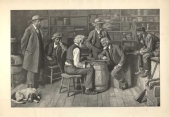The Checker Maven
The World's Most Widely Read Checkers and Draughts Publication
Bob Newell, Editor-in-Chief
Published every Saturday morning in Honolulu, Hawai`i
Noticing missing images? An explanation is here.
Contest 62: Double Breeches

Today we won't go into the difference between breeches and britches, but we will mention that breeches are pants (or if you like, pantaloons) that cover the, um, posterior. Today that's true of most if not all pants.
What then, are double breeches? In terms of pants, we can't really say, but our Research Department did point out that the word breeches is what's known as a double plural. In old English, broc was a word which had a plural form of brec. In time the word evolved and added the usual -(e)s suffix and thus became the double plural, breeches.
If that's just a bit too complicated, fortunately in checkers double breeches has a very specific and easy to understand meaning, as you'll see in Bill Salot's 62nd World Championship Problem Composing Contest, which has double breeches as its theme. Access the contest problems here.
To get you started, here's a sample problem illustrating the contest theme. It's by grandmaster composer Ed Atkinson and was the winner of Contest 33 in June, 2017.
BLACK
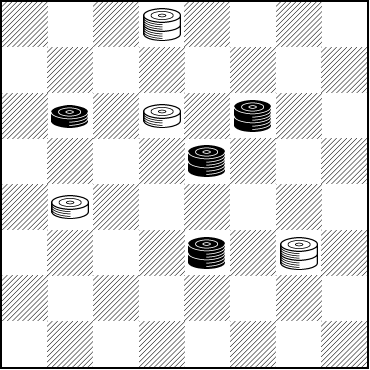
WHITE
White to Play and Draw
W:WK2,10,17,K24:B9,K11,K15,K23
After you've enjoyed solving this problem, click on Read More to see the solution, and then go to the contest page to cast your vote for your favorite among four additional problems.![]()
Warm Up

It's the beginning of May, and in the Northern Hemisphere, the weather should be warming up, likely something very welcome to those of you in colder climes.
Along those lines, today we have a speed problem that is itself in the nature of a "warm up" of the mental type. It's quite easy, and may be something of a good starter to get your brain into checker mode at the start of an evening's play or study.

An experienced player will solve it in a couple of seconds; novices may have to think a bit, but in any case, it's good fun.
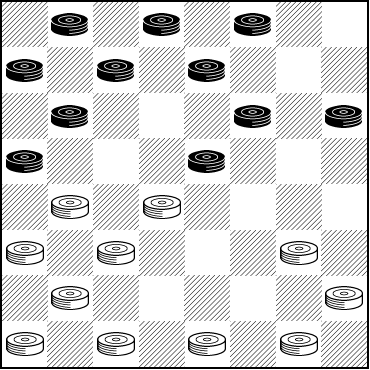
WHITE
White to Play and Win
W:W17,18,21,22,24,25,28,29,30,31,32:B1,2,3,5,6,7,9,11,12,13,15
Were you able to get it? We thought so, but still, warm up your mouse by clicking on Read More to check your play.![]()
Contest 61: Virile Variations

The latest entry in Bill Salot's long-running series of top-notch problem composing competitions is titled Virile Variations and features devious problems with "fake" solutions that conceal the real solution. The idea is that the solver will be misled into thinking the fake solution, which is both appealing and almost but not quite correct, is the real one.
A generous selection of six settings make up the contest entries, which you can quickly access by going to contests.checkermaven.com.
As an introduction, here's a sample problem from 1892, attributed to joint authors G. H. Slocum and C. Hefter.
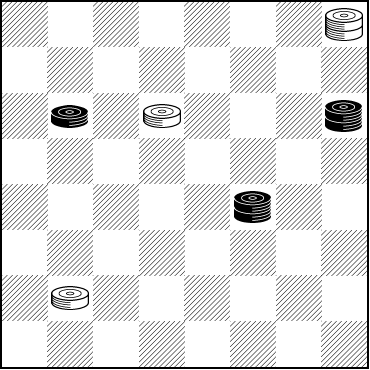
WHITE
White to Play and Draw
W:WK4,10,25:B9,K12,K19
Give this one a try, click on Read More to see the solution (and the fake solution), and then go on over the contest page for six more challenging problems ... and be sure to vote for your favorite!![]()
There's More Than One Way To Do It

There's a sort of a sport played by computer nerds called Vim Golf. Now, bear with us for a moment.
Vim is a famous and venerable text editor used mostly on Unix systems but on many other systems as well. It is unique and has its faithful adherents. It's fast and is famous for being able to accomplish tasks with a minimum of keystrokes. Enter Vim golf.
In Vim golf, players solve an often challenging editing problem, using nothing more than a stock version of the Vim editor. There's more than one way to do it, but the challenge is to solve the problem--- put the ball in the hole, if you will--- with a minimum number of (key)strokes. Just like golf, only very techie. It's a lot of fun--- if that's your sort of thing.
In checkers, too, there is often more than one way to play a position. So we introduce draughts golf with a problem sent along by regular contributors Lloyd and Josh Gordon of Toronto. The position below has several ways for Black to win, but there is a best way.
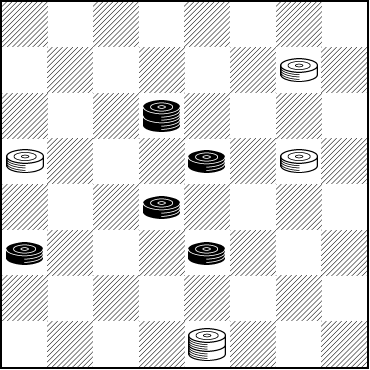
BLACK
Black to Play and Win
B:WK2,17,20,25:B10,12,15,18,K23
Black is a piece up and absent any mitigating factors should of course win. But can you win quickly? Can you find the shortest win? Can you find all of them? Maybe you can't get a hole in one, but can you make par? Take a "shot" and then club Read More to see the solution.![]()
Cute and Acute

Can something be both cute and acute, as in "sharp" or an "acute angle"? We think so, and we're about to show you an example.
This month's speed problem is another easy one, but it's also definitely cute. And acute. You'll see what we mean when you solve it. Beginners might have to think a bit but experienced players should solve it quickly.

BLACK
Black to Play and Win
B:WK7,20,23,24,26,28:B1,12,13,15,19,25,K30
When you've come up with your solution, a cute (or should that be acute) quick of the mouse on Read More will allow you to check your solution.![]()
Zugzwang! Problem Contest 60
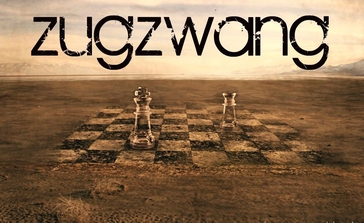
Zugzwang. Compulsion to move, made up of the German roots Zug, move (among other meanings) and zwang, compulsion or force. A situation in which a player has to move even though it will mean losing or incurring a major disadvantage. It's a term commonly associated with the game of chess, but it applies to checkers as well.
The 60th entry in Bill Salot's amazing ongoing series of checker problem composition contests features the theme of Zugszwang with four stellar problems illustrating this principle. Solve them, enjoy them, and by all means vote for the one you think should be the winner.
As always, the action takes place on our current contest page.
To get you started, here's an example. It's by Jim Loy and was the winning problem in Contest 34, August 2017, which featured the same theme as today's contest.
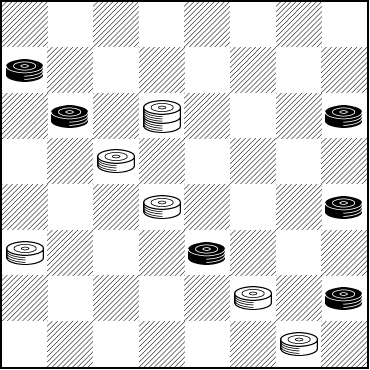
WHITE
White to Play and Win
W:WK10,14,18,21,27,32:B5,9,12,20,23,28
After you've tried this one, click on Read More to see the solution and then hurry over to the current contest page for more Zugzwang enjoyment.![]()
New Year's Day 2022

This column is being published on New Year's Day, 2022, and The Checker Maven wishes that the New Year will bring everyone health, happiness, and everything that you might wish for.

We don't know if or how you might have celebrated on New Year's Eve, but we know that it can often be a time of ... er ... a bit of overindulgence. If you did ... er ... overindulge a little, perhaps today you aren't ready to take on a grandmaster level checker problem. So instead, we'll take it easy on you and present a very nice, but not too difficult problem sent along by regular contributors Josh and Lloyd Gordon of Toronto.
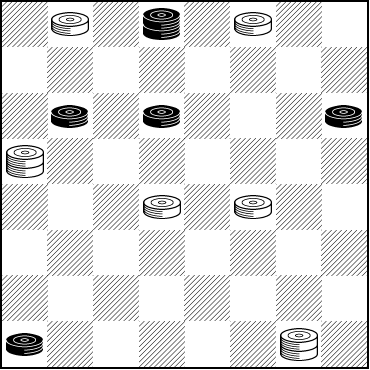
BLACK
Black to Play and Draw
B:WK1,14,15,K20,30,32:B4,21,23,24,K31
This one may take a short moment of thought but shouldn't tax you too much, and might help you to clear your head if that's necessary for you today. Give it a try and then click on Read More to check the solution.![]()
Merry Christmas 2021

This column will appear on Christmas Day, 2021, and whatever holiday you celebrate, in whatever way you celebrate it, The Checker Maven wishes everyone the best of the season. Even in these days of extreme political correctness, we have no hesitation to say "Merry Christmas to one and all," and if you find that friendly wish offensive, that's on you.
On major holidays we like to present problems from great composers of a bygone day. Today, we feature a prize problem by the great Fausto Dalumi. The problem was first published back in 1929, going on a hundred years ago.
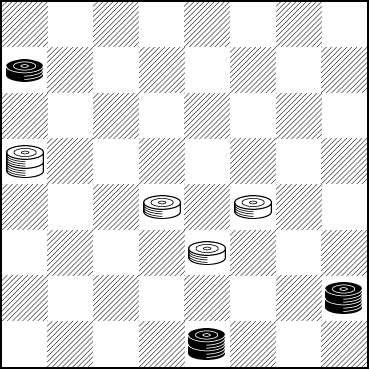
WHITE
White to Play and Win
W:WK13,18,19,23:B5,K28,K31
White is a piece up but winning a won game isn't always easy. We think you'll really enjoy the challenge of this problem. Solve it with good cheer and then merrily click on Read More to celebrate the solution.![]()
State of the Art

Shown above is what's said to be a "state of the art" kitchen. At least, that's what it was ten years ago. But things move ahead. Ten years is a long time. A lot can change.
In recent times, there have been some significant developments in the field of computer checker engines. Machine learning arrived in KingsRow and later in Cake. That was a huge accomplishment, but it wasn't quite the last chapter of the story.
When today's latest computer engines didn't solve Brian Hinkle's "Prize Problem" world class checker programmers Ed Gilbert and Martin Fierz both looked into the issue. Their conclusions were similar and reasonable. Computer engines are set up for maximum strength during practical play, not for solving highly unusual problems.
But of course Ed and Martin didn't stop there. Ed created a selectable "solver mode" for KingsRow while Martin made some changes to the search function in the Cake engine. The Prize Problem was now solvable. (These new program versions have yet to see public release at the time this article was written.)
But Brian didn't stop his work, either, and went on to create a series of more and more unusual problems which took longer and longer for computers to solve..
So what was the outcome? There may always be problems which it simply isn't practical to program computers to solve in any reasonable amount of time. But the state of the art for checker engines has definitely advanced with the intriguing new work done by both Ed and Martin.
Here's one that Brian sent to Ed and Martin. We warn you, it's not easy.
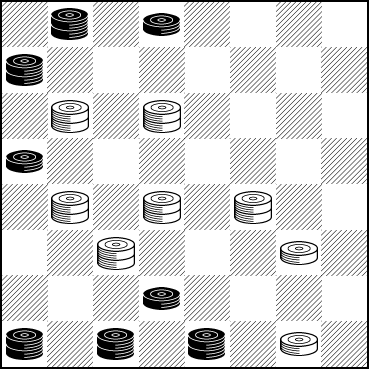
WHITE
White to Play and Win
W:WK9,K10,K17,K18,K19,K22,24,32:BK1,2,K5,13,26,K29,K30,K31
Do attempt a solution on your own before clicking on Read More to see how it's done. These problems are a great deal of fun and definitely test your thinking. Best of luck!![]()
Problem Composing Contest 59: Compound Strokes

In Chinese calligraphy, characters are formed from basic strokes and compound strokes of the writing instrument. The basic stroke involves one movement of the instrument while the compound stroke involves more than one.
In checkers, there are compound strokes as well. We'll let Mr. Bill Salot explain them as part of Unofficial World Championship Problem Composing Contest #59, which is now active and available on the contest page. Four tantalizing and action-packed problems by some of today's finest and most talented composers await your solving pleasure.
Be sure to vote for the one you think best.
Here's a sample of a compound stroke problem. It was the winner of Contest #44.
Leo Springer
BLACK
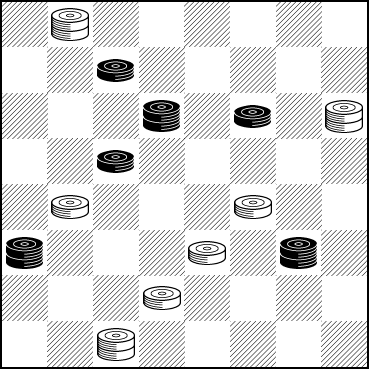
WHITE
White to Play and Win
W:WK1,K12,17,19,23,26,K30:B6,K10,11,14,K21,K24
See if you can sight solve it; lacking that, set it up on your board and try moving the pieces around. But there's no need to compound your frustration; pounding your mouse on Read More will show you the solution.![]()
The Checker Maven is produced at editorial offices in Honolulu, Hawai`i, as a completely non-commercial public service from which no profit is obtained or sought. Original material is Copyright © 2004-2025 Avi Gobbler Publishing. Other material is public domain, as attributed, or licensed under Creative Commons. Information presented on this site is offered as-is, at no cost, and bears no express or implied warranty as to accuracy or usability. You agree that you use such information entirely at your own risk. No liabilities of any kind under any legal theory whatsoever are accepted. The Checker Maven is dedicated to the memory of Mr. Bob Newell, Sr.

